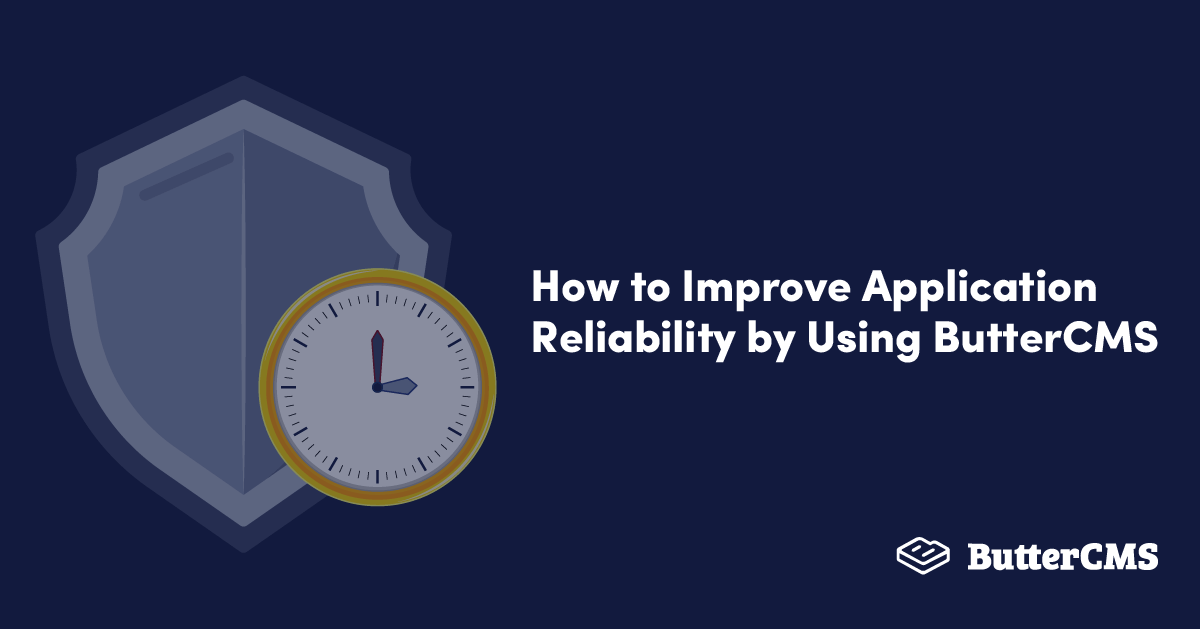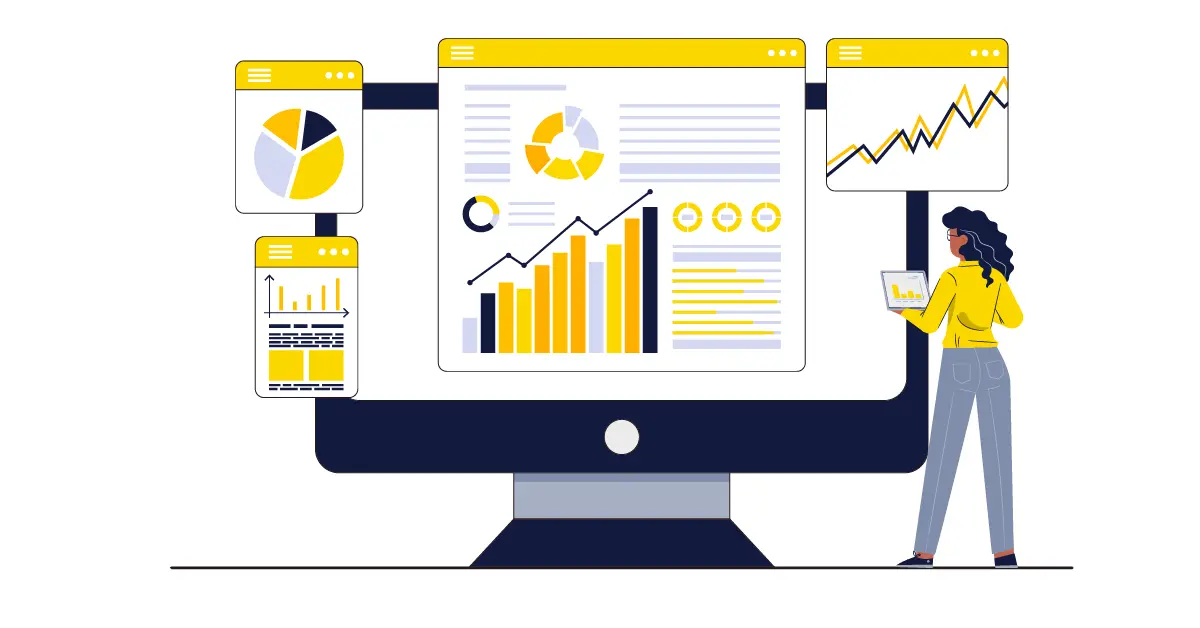- What is application reliability?
- Why is application reliability essential?
- Why is consistent reliability hard to achieve?
- How to ensure your application is reliable
- Why is it a good idea to outsource your back-end with a headless CMS?
- How ButterCMS can help make your application more reliable
- Closing thoughts

GSD
How to Improve Application Reliability by Using ButterCMS
Posted by Paweł Dąbrowski on October 16, 2023
What is reliability? This term is used to describe how a web application will behave in the context of real-world conditions. One of the essential metrics connected to reliability is the performance you can grant to your end users, which is something we’ll discuss further later.
In this article, you will learn why application reliability is so important and how you can increase it by outsourcing the most complex and expensive parts - the building process of the back-end and the infrastructure. In addition, I will discuss the difference between reliability and availability as those terms are often used interchangeably, though they shouldn’t be.
For the purpose of this article, let’s assume that you run a blog application; based on this example, I will show you what reliability with a headless CMS looks like in a real-world case.
Table of contents
What is application reliability?
Application reliability is an application’s ability to perform it’s functions as expected consistently, without errors, failures, or downtime. It is an essential component of software quality and necessary to provide users with a dependable experience.
However, in practice, it is hard to achieve as your application can experience a variety of situations that are hard to predict: traffic spikes, hacker attacks, or hardware problems caused by natural disasters.
So, how can you measure reliability?
You could use some formulas like MTTF (mean time to failure), MTTR (mean time to repair), or MTBF (mean time between failures), but it will be easier just to define a set of questions you should ask yourself regarding your application:
- Would your application be able to work correctly when one of the servers stops working because of a hardware problem?
- Would your application be able to work correctly when the traffic is tripled or quadrupled?
- Would your application be able to work correctly when you experience a DDoS attack?
- Would your application be able to work correctly again if one of your developers deletes the database?
- Is the rate of successful end-user requests more than 99%?
If you answered yes to all these questions, congratulations! Your application reliability is very high. Otherwise, it is time to think about how you can improve your architecture to assure your users that you are prepared for some exceptional cases.
The difference between reliability and availability
Let’s say that you are at a gas station and want to inflate your car's tires. Is the tire inflation device ready to use? That’s the availability. Does it pump the air with the optimal power? That’s the reliability.
As you can see, both terms are strictly related, but they are not the same. In other words, availability is when your application is operational under normal circumstances, and reliability is the probability that the application will meet its performance standard and yield the correct output.
Why is application reliability essential?
If your users cannot use the application because it is slow or raises errors, they will probably go to your competitor, which means losing profit for your business. Therefore, high reliability is one of the most critical factors for every application.
Your application can have the best features and solve the most complex problems, but if the reliability is low, your users won’t have a chance to know about it. These days, many startups achieve success not because they solve problems that nobody solved before but because they solve the same issues and assure outstanding reliability to the end users.
A reliable application is a scalable and consistent application
You can’t avoid all risks as you can’t control everything—for example, natural disasters. But losing one or more servers doesn’t have to mean that your app will become inaccessible. An application can scale automatically by redirecting traffic from offline instances to healthy ones or spinning up new instances if needed.
The downtime caused by losing one or more servers can impact not only your end users but also your internal systems. Modern applications are based on multiple smaller systems that are in instant communication. Losing one of these elements can impact the data integrity between all systems.
Why is consistent reliability hard to achieve?
You first have to take reliability into account during the application design stage. The more complex the infrastructure is, the harder it is to achieve consistent reliability. You often have to take care of the database, web servers, and other software like cache servers.
The code is also another difficult part, as poorly designed algorithms or processes can take down your application easily if your developers don’t think about scalability during development. What’s more, if we are talking about development, it’s also worth mentioning the testing phase. QA specialists need to test the application against problematic scenarios where the reliability of the application is verified.
Creating an application design itself is problematic. If you add infrastructure design and proper testing to it, the whole process becomes more complex and expensive.
How to ensure your application is reliable
As I mentioned above, there are two sides to this coin. One is the application's code, and the second is the infrastructure architecture responsible for serving the application.
To ensure that your application is reliable thanks to the code:
- Update the software frequently.
- Refactor the application’s code to make it more readable and extendable.
- Find bugs and fix them as soon as possible.
- Make sure that new features are bug-free.
In terms of the infrastructure:
- Use load balancers for your servers.
- Have a disaster recovery and business continuity plan.
- Implement DDoS protection.
- Back up your data.
Why is it a good idea to outsource your back-end with a headless CMS?
From day one, a headless CMS can become one of the most reliable elements of your application. You can easily move from hundreds to thousands of API calls per minute.
While you are responsible for how the content is presented to the end users, the headless CMS provider takes responsibility for the operational layer that consists of web and database servers.
You no longer have to worry about traffic spikes, data backup, or protection from DDoS attacks. You can quickly improve reliability in the following application types:
- Blogs
- Marketing sites for SaaS, eCommerce, or Marketplace
- Multi-channel sites like portfolio pages
You increase reliability by using API endpoints; this solution's technical side is in the hands of experts, and you don’t worry about costs and management.
How ButterCMS can help make your application more reliable
As I mentioned, there are multiple ways you can build excellent application reliability at the code and infrastructure levels. Here’s how ButterCMS handles these different aspects so you don’t have to worry about it.
Scalability from day one
You no longer have to worry about traffic spikes. In every case, you will get your content in the same way and at the same time. ButterCMS takes care of the load balancers that automatically add new servers if the traffic is more significant or replace unhealthy servers that no longer handle requests.
If you publish a new article, and it becomes very popular because someone mentioned it in a popular YouTube show, with ButterCMS your users don’t have to wait longer for the page to load than they usually wait when requesting less popular articles. Load balancers will detect more traffic and the system will trigger new servers automatically to handle more visitors.
Improved performance
ButterCMS uses a content delivery network (CDN) infrastructure to provide the content faster. Thanks to that, if you request the data from Europe and the server is in the United States, you will get the content from one of the cache servers in Europe instead of the original one.
Your blog visitors won’t have to wait longer just because they live in a different part of the world. From every place on the globe, your blog will load with the same speed and the application itself will use fewer transfers, which is a mobile-friendly approach.
DDoS protection
Distributed Denial of Service (DDoS) attacks can bring the whole application down if the architecture is not designed to prevent such a situation. ButterCMS protects users at the CDN level and also with the load balancer and through AWS Shield.
As your blog becomes more popular, it can gain more attention from people with bad intentions. Applications based on a traditional monolithic architecture may be easily affected by DDoS attacks. With ButterCMS, you are safe as your content is protected and it will be available for your users without any interruptions thanks to modern cloud architectures.
Proper database management
Thanks to database replication, you don’t have to worry about the uptime of the database or proper redundancy. Your data is also automatically backed up with encryption, stored onsite at the data center, and copied to a remote storage location.
Content is the new currency of the internet, and it’s very valuable. You can’t risk losing it due to incorrect maintenance of the database. Thanks to headless CMSs, all you are worried about is creating the content.
Closing thoughts
Regardless of size, when you build a web application, you must design your infrastructure and code for high reliability. Without performance at the right level and bug-free features, you won’t be able to attract or keep many users for a long time.
Increased reliability is hard to achieve, no doubt about it. However, you can outsource part of the application with the headless CMS approach and sleep well, as the reliability of that solution is in good hands.
ButterCMS is the #1 rated Headless CMS
Related articles
Don’t miss a single post
Get our latest articles, stay updated!















Paweł is a self-made writer of the digital era, IT samurai and problem solver who loves Ruby. He writes for human beings and computers at pdabrowski.com and focuses on soft skills in the software creation process.